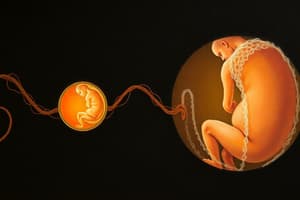Podcast
Questions and Answers
What is the first event triggered by the binding of sperm to the egg membrane during conception?
What is the first event triggered by the binding of sperm to the egg membrane during conception?
- Formation of the morula
- Cortical reaction (correct)
- Activation of egg enzymes
- Meiotic completion
During which week of embryogenesis does the blastocyst typically implant into the endometrium?
During which week of embryogenesis does the blastocyst typically implant into the endometrium?
- Week 3
- Week 4
- Week 1 (correct)
- Week 2
Which hormone is secreted by trophoblasts upon implantation to maintain the corpus luteum?
Which hormone is secreted by trophoblasts upon implantation to maintain the corpus luteum?
- Luteinizing hormone (LH)
- Human chorionic gonadotropin (hCG) (correct)
- Follicle-stimulating hormone (FSH)
- Progesterone
What is the origin of the germ layers that form all tissues and organs of the embryo?
What is the origin of the germ layers that form all tissues and organs of the embryo?
In the context of early embryo development, what is the function of the cortical granules?
In the context of early embryo development, what is the function of the cortical granules?
Which process occurs during week 3 of embryogenesis?
Which process occurs during week 3 of embryogenesis?
What is a primary function of Human Chorionic Gonadotropin (hCG) during the first trimester of pregnancy?
What is a primary function of Human Chorionic Gonadotropin (hCG) during the first trimester of pregnancy?
What role does progesterone play in maintaining a pregnancy?
What role does progesterone play in maintaining a pregnancy?
Which hormone's levels are monitored in the mother's blood as an indicator of fetal health?
Which hormone's levels are monitored in the mother's blood as an indicator of fetal health?
What is a primary function of human placental lactogen (hPL) during pregnancy?
What is a primary function of human placental lactogen (hPL) during pregnancy?
Why are pregnant women susceptible to supine hypotension, particularly in the later stages of pregnancy?
Why are pregnant women susceptible to supine hypotension, particularly in the later stages of pregnancy?
What is the primary role of relaxin during parturition?
What is the primary role of relaxin during parturition?
Which hormones are involved in alveoli dilation during lactation?
Which hormones are involved in alveoli dilation during lactation?
What is the coordinated action that induces parturition?
What is the coordinated action that induces parturition?
Which of the following is the positional remedy to prevent hypotension in a pregnant woman in the dental chair?
Which of the following is the positional remedy to prevent hypotension in a pregnant woman in the dental chair?
What is the underlying mechanism of maternal diabetes that causes fetal macrosomia?
What is the underlying mechanism of maternal diabetes that causes fetal macrosomia?
What modification to the metabolic state in the mother facilitates meeting the energy supply of the fetus?
What modification to the metabolic state in the mother facilitates meeting the energy supply of the fetus?
How do shunts in fetal circulation support development before birth?
How do shunts in fetal circulation support development before birth?
What is the primary cause of neonatal hypoglycemia in babies born to mothers with gestational diabetes?
What is the primary cause of neonatal hypoglycemia in babies born to mothers with gestational diabetes?
What oral health condition is associated with high levels of progesterone during pregnancy?
What oral health condition is associated with high levels of progesterone during pregnancy?
If a pregnant patient reports feeling dizzy and nauseous while lying in the dental chair, what is the most likely cause?
If a pregnant patient reports feeling dizzy and nauseous while lying in the dental chair, what is the most likely cause?
What is the long-term effect of maternal gestational diabetes on offspring?
What is the long-term effect of maternal gestational diabetes on offspring?
During the process of fertilization, what prevents more than one sperm from fertilizing an egg?
During the process of fertilization, what prevents more than one sperm from fertilizing an egg?
A pregnant woman is diagnosed with gestational diabetes during her second trimester. Which of the following complications is most directly linked to the excessive fetal insulin production caused by this condition?
A pregnant woman is diagnosed with gestational diabetes during her second trimester. Which of the following complications is most directly linked to the excessive fetal insulin production caused by this condition?
Which of the following best describes the role of the amniotic cavity formed during the second week of embryogenesis?
Which of the following best describes the role of the amniotic cavity formed during the second week of embryogenesis?
A researcher is studying the effects of different hormone concentrations on uterine contractility during pregnancy. Which hormone should be targeted to reduce uterine contractions and maintain pregnancy?
A researcher is studying the effects of different hormone concentrations on uterine contractility during pregnancy. Which hormone should be targeted to reduce uterine contractions and maintain pregnancy?
Which laboratory finding would be MOST indicative of a positive pregnancy test shortly after implantation?
Which laboratory finding would be MOST indicative of a positive pregnancy test shortly after implantation?
A clinician notes that a pregnant patient has developed a small, red, vascular lesion on her gingiva. The lesion bleeds easily when touched What is the likely diagnosis?
A clinician notes that a pregnant patient has developed a small, red, vascular lesion on her gingiva. The lesion bleeds easily when touched What is the likely diagnosis?
A woman in her third trimester is brought to the emergency room, feeling faint and hypotensive while lying supine after a minor car accident. What immediate action should the medical staff take to improve her blood pressure?
A woman in her third trimester is brought to the emergency room, feeling faint and hypotensive while lying supine after a minor car accident. What immediate action should the medical staff take to improve her blood pressure?
A researcher aims to study the role of decidual natural killer (NK) cells during early pregnancy. Disrupting which hormonal influence would MOST DIRECTLY affect the function of the decidual NK cells?
A researcher aims to study the role of decidual natural killer (NK) cells during early pregnancy. Disrupting which hormonal influence would MOST DIRECTLY affect the function of the decidual NK cells?
A dental hygienist notices increased gingival inflammation in a pregnant patient who reports frequent vomiting due to morning sickness. What advice should the hygienist provide to minimize the erosion of enamel from stomach acid?
A dental hygienist notices increased gingival inflammation in a pregnant patient who reports frequent vomiting due to morning sickness. What advice should the hygienist provide to minimize the erosion of enamel from stomach acid?
Imagine a clinical trial testing a new drug designed to prevent preterm labor. Which of the following mechanisms of action would be MOST effective in prolonging pregnancy?
Imagine a clinical trial testing a new drug designed to prevent preterm labor. Which of the following mechanisms of action would be MOST effective in prolonging pregnancy?
A woman who is 8 weeks pregnant experiences severe hyperemesis gravidarum. If left untreated, which of the following complications is MOST likely to affect the neonate?
A woman who is 8 weeks pregnant experiences severe hyperemesis gravidarum. If left untreated, which of the following complications is MOST likely to affect the neonate?
A researcher discovers a novel protein that is expressed solely in the trophoblast cells shortly after implantation. What is the MOST LIKELY function of this protein?
A researcher discovers a novel protein that is expressed solely in the trophoblast cells shortly after implantation. What is the MOST LIKELY function of this protein?
While reviewing fetal blood circulation, a medical student asks, "If the ductus venosus directly shunts oxygenated blood away from the liver in the fetus, what indirect consequence does this have on fetal liver development?"
While reviewing fetal blood circulation, a medical student asks, "If the ductus venosus directly shunts oxygenated blood away from the liver in the fetus, what indirect consequence does this have on fetal liver development?"
An astute embryologist, reflecting on the critical events of the second week of human development, poses a deceptively challenging question: 'If normal formation of the epiblast is completely disrupted during week 2, what is the absolute MOST DIRECT consequence for subsequent development?'
An astute embryologist, reflecting on the critical events of the second week of human development, poses a deceptively challenging question: 'If normal formation of the epiblast is completely disrupted during week 2, what is the absolute MOST DIRECT consequence for subsequent development?'
Flashcards
Time of Conception
Time of Conception
Binding of the first sperm to the egg membrane, initiating cortical reaction, meiotic completion, and activation of egg enzymes.
Week 1 of Embryogenesis
Week 1 of Embryogenesis
Early cleavage occurs in the fallopian tube, and the blastocyst implants into the endometrium.
Trophoblast Function
Trophoblast Function
Outer layer of blastocyst, secretes hCG, supports corpus luteum for steroid secretion, later forms part of the placenta.
Inner Cell Mass
Inner Cell Mass
Signup and view all the flashcards
Week 2 of Embryogenesis
Week 2 of Embryogenesis
Signup and view all the flashcards
Week 3 of Embryogenesis
Week 3 of Embryogenesis
Signup and view all the flashcards
Human Chorionic Gonadotropin (hCG)
Human Chorionic Gonadotropin (hCG)
Signup and view all the flashcards
Progesterone's Role
Progesterone's Role
Signup and view all the flashcards
Estrogen's Role
Estrogen's Role
Signup and view all the flashcards
hPL's Role
hPL's Role
Signup and view all the flashcards
Supine Hypotension Cause
Supine Hypotension Cause
Signup and view all the flashcards
Relaxin's Role
Relaxin's Role
Signup and view all the flashcards
Maternal Metabolic State
Maternal Metabolic State
Signup and view all the flashcards
Fetal Shunts Role
Fetal Shunts Role
Signup and view all the flashcards
Gestational Diabetes Cause
Gestational Diabetes Cause
Signup and view all the flashcards
Tooth Decay
Tooth Decay
Signup and view all the flashcards
Pregnancy Gingivitis
Pregnancy Gingivitis
Signup and view all the flashcards
Pregnancy Tumor (pyogenic granuloma)
Pregnancy Tumor (pyogenic granuloma)
Signup and view all the flashcards
Role of HPL
Role of HPL
Signup and view all the flashcards
Pregnancy
Pregnancy
Signup and view all the flashcards
Parturition
Parturition
Signup and view all the flashcards
Cervix
Cervix
Signup and view all the flashcards
Study Notes
- A pregnant woman's body undergoes dramatic hormone-induced changes to allow for fetal growth.
Conception to Early Embryo Development
- Fertilization happens when the first sperm binds to the egg membrane.
- The sperm head enters the egg, resulting in a cortical reaction to block polyspermy.
- Meiotic completion occurs, leading to a zygote and activation of egg enzymes.
- Early cleavage, from the zygote to the morula stage, occurs in the fallopian tube.
- The blastocyst travels to the uterine cavity, hatches, and invades the endometrium about a week before the next cycle.
- A blastocyst consists of trophoblasts (extraembryonic cells) and an inner cell mass (embryonic stem cells).
- Trophoblasts secrete human chorionic gonadotropin (hCG) to support the corpus luteum in steroid secretion during the first trimester and later form part of the placenta.
Hormone changes during pregnancy weeks 1 and 2
- During the first two weeks HCG secretion continues.
- Estrogen and progesterone secretion from the corpus luteum are supported.
- Morphological changes in the embryoblast produce a bilaminar embryonic disc composed of epiblast and hypoblast.
- The embryonic disc gives rise to germ layers that form tissues and organs of the embryo.
The Placenta
- Construction begins from extraembryonic structures: amniotic cavity, amnion, umbilical vesicle connecting stalk, and chorionic sac.
Week 3
- Gastrulation occurs, generating three germ layers: ectoderm, endoderm, and mesoderm.
Hormones of Maternal Pregnancy
- Includes human chorionic gonadotropin, progesterone, hPL, estrogen, and relaxin.
- Possible Pregnancy Complications:
- Hemodynamics issues (anemia, hypertension).
- Mood swings (anxiety, depression).
- Hyperemesis gravidarum (morning sickness), infections, and being overweight.
- Endocrine gland dysfunction (diabetes, hypothyroidism).
hCG (Human Chorionic Gonadotropin)
- Maintains the function of the corpus luteum (CL) during the first trimester.
- The CL secretes estrogen and progesterone.
- hCG is secreted by trophoblasts of the implanted blastocyst and continues to be secreted when they become a part of the placenta.
- hCG is used to diagnose pregnancy and some cancers.
- There is immunomodulation at the maternal-fetal interface.
- T-cell activation is reduced.
- Immuno-suppression is induced through Treg.
- There is an increase in uterine NK cells.
Progesterone
- It is essential for maintaining the quiescent endometrium.
- Progesterone comes from the CL (1st trimester) and the placenta (2nd-3rd trimesters).
- Decreases contractions of smooth muscle and immune responses (immunomodulatory).
- Progesterone antagonist: a medical abortifacient (e.g., mifepristone).
Estrogen
- It stimulates uterine growth to accommodate the growing fetus and breast development.
- An estrogen is required for progesterone action.
- Estrogen stimulates smooth muscle contraction.
- Estriol synthesis requires a contribution from fetal organs.
- Estriol in the mothers blood shows fetal health.
Maternal Blood Volume
- Maternal blood volume is associated with high plasma levels of building blocks for fetal growth (glucose, amino acids, fat).
- Umbilical arteries carry fetal blood high in wastes and CO2.
- Umbilical veins carry fetal blood high in nutrients and O2.
Exchange of Nutrients
- Nutrients comes from the mother
- Exchange of these nutrients occurs through syncytiotrophoblasts.
- Passive Diffusion: gases, fat-soluble vitamins, fatty acids, steroids.
- Facilitated Diffusion: glucose.
- Active Transport: amino acids, water-soluble vitamins, Ca++, Fe, I- Endocytosis for phospholipids, globulin, lipoproteins (e.g., LDL, HDL).
- Fetal Circulation:
- Shunts bypass the lungs and liver, which do not work fully until after birth.
- These shunts direct oxygenated blood to bypass certain body parts (lungs and liver) that are not fully developed while the fetus is still in the womb
Supine Hypotension
- A pregnant woman is prone to supine hypotension in the dental chair.
- Hypotension is caused by supine position due to aortocaval compression by the vertebrae during later pregnancy (20th week gestation and beyond).
- Presents as pallor, tachycardia, sweating, nausea, hypotension, and dizziness.
- Tilt the body 15 degrees to the left by placing rolled towels under the right side of the spinal board to avoid supine hypotension.
Relaxin
- Involved in parturition/labor and helps relax ligaments in the pelvis.
- Softens and widens the cervix to dilate; increase uterine oxytocin-R.
- Relaxin effects tooth movement.
hPL (human placental lactogen)
- Also called human chorionic somatomammotropin (HCS).
- Mimics the action of prolactin and growth hormone.
- Stimulates mammary cell proliferation.
- Modifies the metabolic state of the mother during pregnancy to facilitate the energy supply of the fetus.
- Implicated in the development of gestational diabetes.
Gestational Diabetes
- Gestational diabetes can come from excessive activities of the Pregnancy-Associated Hormones on the metabolic state.
- Diagnosed in the 2nd-3rd trimesters.
- Risk factors include:
- Overweight or obese.
- Physical inactivity.
- Polycystic ovary syndrome.
- Genetics.
- Non-white race.
- Results from beta cell hyperplasia, hyperinsulinemia, insulin resistance (reduced glucose utilization by the mother), and hyperglycemia.
Maternal Diabetes
- Can cause Fetal Macrosomia
- Symptoms in a Pregnant Mother:
- Large fundal height.
- Polyhydramnios (excessive amniotic fluid).
- Risks for Parturition/Delivery:
- Labor might need C-section.
- Possible uterine rupture.
- Genital tract injury.
- Possible post-delivery bleeding.
- Complications of Fetal Development:
- Macroglossia (large tongue).
- Dentoalveolar abnormalities (development of long narrow faces and high palates).
- Developmental enamel defects (tooth formation beginning the 4th week and mineralization beginning around 4 to 6 months of pregnancy).
- Increased risk of dental caries and obesity in childhood.
- Maternal Hyperglycemia Causes Hyperplasia of Fetal Pancreas and Neonatal HYPOGLYCEMIA:
- Develops at 5 weeks of age.
- Secretes insulin by 12 weeks of age.
- Fetal insulin levels reflect the size of the endocrine pancreas (more β-cells)
- Neonatal HYPOGLYCEMIA:
- Elevated levels of fetal insulin persist even after birth.
- Lack of glucose (no maternal supply). Gestational Diabetes is linked to Limited Fetal Growth & Development:
- Several metabolic risks link maternal GDM to fetal growth and development.
- There are dysfunctions in glucose, insulin, and lipid pathways.
- Long-lasting on her offspring (fetus, infant, child, and adult).
- Several metabolic risks link maternal GDM to fetal growth and development. These
- Metabolic effects occur involving dysfunction in glucose, insulin, and lipid pathways.
- Effects are long-lasting on her offspring/ the lifespan of her offspring (fetus, infant, child, and adult).
- Gestational Diabetes is is associated with a decline of oral health.
- Steroid Hormone-Induced Changes in Oral Cavity are Highly Associated with Detrimental Oral Conditions
- Gestational diabetes mellitus increases the frequency of developmental defects of enamel (DDE) in the offspring.
Pregnancy and Oral Health
- Oral health can be declined due to gestational diates
- Pregnancy Gingivitis:
- Is an inflammation of the gums (redness, swelling, tenderness).
- Can arise due to high levels of progesterone.
- Often develops during the second trimester.
- managing pregnancy to prevent periodontiis
- Occasionally a red vascular lump develops on the gums - pregnancy tumor (pyogenic granuloma).
Extensive Breast Development During Pregnancy
- Prepubertal mammary glands are rudimentary with ducts primarily.
- Pubertal changes are caused by hormones estradiol (E), progesterone (P), cortisol (C), insulin (I), growth hormone (GH), and prolactin.
- Mammary glands are mainly consisted of ducts and a few alveoli.
- Pregnancy increases numbers and size of alveoli due to high E, P, C, I, and hPL. During lactation, alveoli are dilated due to prolactin and oxytocin. After weaning, the gland regresses.
Parturition
- Parturition is induced by coordinated estrogen, oxytocin, and prostaglandin for uterine contraction and dilation & thinning of the cervix (relaxin).
- Hypothalamus releases oxytocin.
- The cervix then stretches.
- The stretch of the cervix (relaxin) tells the hypothalamus to release oxytocin.
- This causes uterine contractions and further cervical dilation.
- Positive feedback mechanism.
Studying That Suits You
Use AI to generate personalized quizzes and flashcards to suit your learning preferences.





